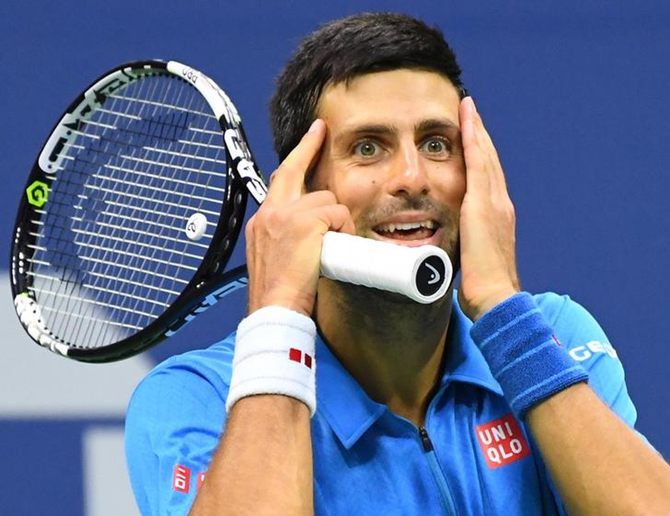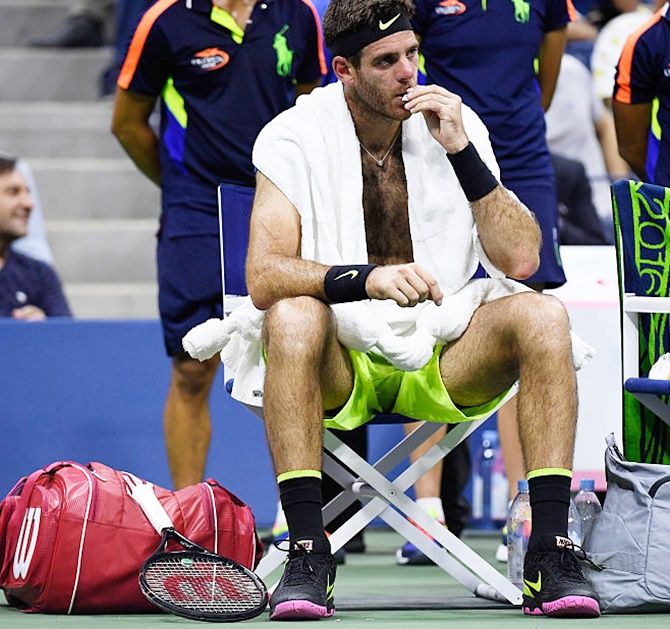'Not only are four of the top five fathers, but Federer famously injured a knee, weakened by years of twisting and turning on tennis courts, early this year while giving his elder pair of twins a bath.'
Rahul Jacob mulls on tennis' future from a ringside view at the US Open.

Injury was such a recurrent theme at this year's US Open that it often seemed it should have been the top seed.
Before the event even began, the spotlight was on World No 1 Novak Djokovic's injured wrist, which was believed to be the main reason behind his indifferent summer results, including a first-round loss at the Olympics.
Roger Federer was not even at Flushing Meadows, having elected to sit out the rest of 2016 to allow a knee injury to heal.
And, that was just the beginning. I was courtside as the first of the top seeds fell. The Canadian Milos Raonic, runner-up at Wimbledon, was beaten not by his opponent, the American qualifier Ryan Harrison who hasn't won a first round at a Grand Slam event in two years, but by cramps so peculiarly debilitating that it was as if an unseen band of Lilliputians was taking down the giant.
Raonic, whose pace of serve and volleying had knocked Federer to the ground at Wimbledon, was overcome by mini-seizures as the cramps travelled from his left wrist to his right hand to his thighs.
This was a US Open dressed in the neon colours of highlighter Day Glo pink and yellow even as darker questions -- the absence of compelling rivalries at the top of men's tennis, the even more fearful 'After Serena, what?,' hung over the sport.
One moment Jo-Wilfried Tsonga, a behemoth even in baby pink, was musing wishfully about reaching the semi-finals, the next he was conceding defeat to Djokovic, complaining of a recurrent knee injury.

Incredibly, Djokovic reached the semi-finals after two of his five opponents retired hurt, and one gave him a walkover.
At the beginning of the fourth set as the clock approached 1 am, the physios somehow tended to both Stanislas Wawrinka and Juan Martin Del Potro.
What seems different this time from, say, Wimbledon in 2013, which saw seven players pull out on one day, is how many of the players at the very top are either grappling with injury or making a comeback from one.
The Cinderella this year was Del Potro, ranked 142. Even after three wrist surgeries, the Argentine lacks the power to hit a full-blooded two-handed backhand. Del Potro is now limited to a sliced backhand, which Wawrinka curiously avoided, perhaps because the Swiss deemed it unsportsman-like to rub salt into that wound.
Add it all up and tennis's present and future seems much poorer. Certainly, men's tennis has never seemed so middle-aged.
Not only are four of the top five fathers, but Federer famously injured a knee, weakened by years of twisting and turning on tennis courts, early this year while giving his elder pair of twins a bath.

Interviewed against the pristine Swiss Alps, Federer, 35, spoke of the need to sit out the rest of 2016 in order to be healthy for what he improbably predicts will be a few more years of pro tennis.
But even the baby-faced Dominic Thiem and the temperamental Nick Kyrgios are plagued by injury.
Thiem, who hits with some of Federer's fluid grace, turned 23 to a 'Happy Birthday' from the fans only to withdraw from the next match because of a hauntingly painful knee injury.
The 21-year-old Kyrgios began the US Open on the cover of The New York Times magazine heralded for his McEnroe-like talent, but limped off the court with a right hip injury in the third round. Both sat out the Olympics.
Tennis has mostly been an upper middle-class sport, and is now cursed by white-collar repetitive strain injuries brought on by too much of the season being on the hard courts that are symbolised by Flushing Meadow and the Australian Open and their warm-ups -- and, paradoxically, by ever more powerful rackets.
The calendar was shortened by a month a few years ago, but the injury toll just keeps rising. The sport is in essence condemning its players to hurl themselves about on garishly dressed up concrete for much of the year.
Sitting courtside during the Wawrinka-Del Potro match was Guillermo Vilas, the last man to win the US Open on clay in 1977, a reminder that a return to a slower past of clay courts for the US summer season would achieve both more engaging tennis and lower the brutal toll on players' bodies.
And, yet, like so much about this once infectiously optimistic country, it is hard to be hopeful that the obvious answer will be the one chosen.
The new roof on the Arthur Ashe court has come with awful acoustics, making a bad stadium even noisier. (It seemed a metaphor: The unambitiously piecemeal refurb of New York's airports only highlights how very seventies the infrastructure of the US is by comparison to Beijing, Seoul and Singapore.)
Even so, it is hard to drown out the inanity of this wearying presidential campaign, or ignore the worrying befuddlement of central bankers at the recent meetings in Jackson Hole as they fail to reignite economic growth worldwide.
A deceptively beautiful autumn has descended on New York, but brace yourself for many seasons of unending middle-class discontent.
Why would tennis be immune?













 © 2025
© 2025